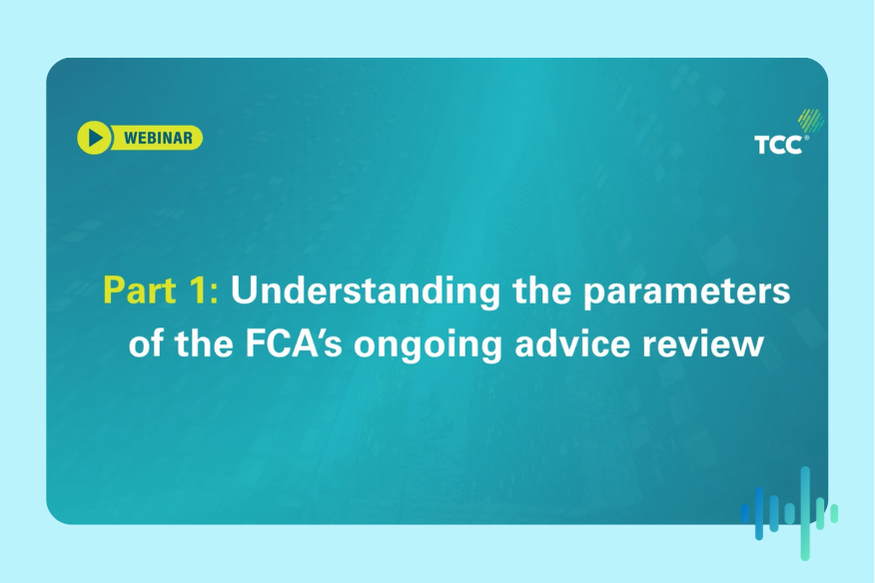Our sister company TCC recently held a well-received webinar entitled ‘What risks remain for firms following the FCA’s ongoing advice review findings?’ to share their house view on the regulator’s latest communication for wealth managers.
In part two of our sister company TCC’s recent webinar entitled ‘What risks remain for firms following the FCA’s ongoing advice review findings?’ they continue to share their house view on the regulator’s latest communication for wealth managers. Recordsure’s Chief Product and Chief Commercial Officer, Garry Evans, was joined by TCC’s in-house regulatory experts, Gary Maude and David Boyhan.
Watch the second instalment, where they unpack the all-important next steps for wealth managers to help ensure regulatory expectations are met, or read the transcript below.
Garry Evans
Okay. Along with all the other changes that the wonder of Consumer Duty has brought, evidence does appear to be the keyword when considering what the FCA are looking for. I’m going to use that as a lead into our second poll about evidence. I’d like you guys to provide your view on whether you are confident that you have the evidence to accurately categorise clients into the three categories of: received a substantive review, have been offered but declined or didn’t engage, or didn’t get offered a review for each of the service review periods back to the start of 2018, which is the time that the FCA has called out.
So for those of you that have said yes or some to the previous poll, I want to run a quick follow-up specifically on the type of evidence that you have, and that you are going to be using, to determine which category individual clients are in for each of those service review periods.
I’m keen to understand whether you guys have the documents that show that that has been done, whether you are utilising practice management system data, whether there’s something else or, in the case of those who haven’t got any at all
Exciting, great, well that’s interesting. So over 60% of those that have responded actually have the proper evidence, which I think is it’s really positive.
Now this leads us into the meat of the webinar. So, Gary, David, can I hand over to you to firstly provide a TCC house view on what evidence is required? And secondly, with what you as wealth managers need to do once you’ve identified which categories those individual clients fall into for each of those service periods back to 2018.
David Boyhan
Thanks Garry, I’ll take a lead on this. And then I’ll pass over to Gary. First of all, those poll results as you say are positive – it’s good that the majority of firms believe they’ve got the evidence, or at least some of the evidence, and that includes fact finds and report letters as well. So that’s always great to see.
I think it’s important to also remember that as far as we’re concerned, there’s two pieces of work that need to be undertaken by firms. The first is a backwards looking piece which I’m going to concentrate on, but there’s always a forward-looking piece as well in terms of FCA expectations now that it’s produced the findings from its report. I think the key thing here is it’s been discussed already: it’s very clear the FCA expect a backwards-looking piece to go back to January 2018 when method two requirements came into play.
For anyone on this call who got the letter from the FCA last February, I believe they went back to 2017. I think the FCA has been very clear, you only need to go back to 2018 now. So that’s a positive.
And the other thing, the FCA was very clear about in its report was it grouped clients into three distinct areas. The first is one we all want to be in – that’s a client who has received a review, which is fantastic. That’s great news – and the FCA found the majority over 80% in that bucket. But then there were two other buckets of clients. The first were clients who had been offered a review but didn’t engage in the process. And then there were clients who weren’t engaged or weren’t invited to engage.
When you go back to do your reviews, you need to go back to 2018, and you need to look at clients in those three buckets. Now the key point, as Garry’s just mentioned, is what evidence do you need for each of those groups of clients? Our view is if you’ve got a completed review for a client, the minimum that you’d need to have on file is updated KYC. You know, in some instances that might be a note saying that the client confirmed there’d be no changes, but you need something relevant from that period of advice to say that you’ve got updated KYC. Whether the client’s circumstances have changed or have not changed.
And you also need, a report letter as well, confirming ongoing suitability. Those are the two things that we see as being fundamental, for demonstrating that a review has been completed.
Perhaps more subjective, is clients that have been asked to engage, but have decided not to engage. And I think the FCA said this was around about 15% of clients. The TCC view is that you need to have some documented evidence that the client was invited to engage in the process. That could be for example, an email that you’ve got from maybe 2018 or 2019 that the client, was asked to engage but they didn’t. In an ideal world, you’d like to have some chasers as well, but as a minimum, we would suggest that you have at least one email, demonstrating the client was asked to, to engage in the process.
And then the final bucket is the easiest bucket if you’ve got no records of anybody being contacted, no phone calls, they would fall in the process where the client wasn’t given the opportunity to engage.
When you go back to 2018, you need to put your client into those three different categories. But it’s also vitally important that you do it on an annual basis. You might have a client who missed one review in 2019 perhaps refusing every other year. And you might have some clients who received no reviews for five years in a row. So, you need to get that level of MI and then make the decision as to how you’re going to treat clients who missed one review as compared to the client who might have missed four or five. That’s a key thing in terms of doing your backwards-looking review in terms of MI, you need. Then your risk departments make a decision on what action to take with each of those clients.
And just quickly before I pass back to you Gary, in terms of the forward-looking piece I think the FCA has been very clear on their expectations. So, you need to look at things such as fair value assessments, you need to be looking at your ongoing advice processes for disengagement and so forth. But I think we’re going touch on that a little bit later.
With that, with two Gary’s on the call, I’ll hand over to Gary Maude in case there’s anything else you wanted to add on that?
Gary Maude
Just a couple of bits to jump on your coattails really David. I think, I’m one of the glass half full people in the room, so bear with me, and hopefully it will add value.
In the past, things like TR241 were much more prescriptive in black and white weren’t they, i.e. no service, no fee – the landscape is clean moving there. There is scope to miss appointments, there is scope where to take a fee even if circumstances haven’t changed.
But I would remind firms of the evidence point. As we said earlier, and in terms of ripple effect, to bring in a couple of the MI poll results that didn’t surprise me because both in terms of ongoing advice but also in terms of general quality advice. We see within firms when we do a Section 166 or vrex or assurance or audit is that the common problem is advisers aren’t clear.
In putting together evidence to demonstrate what advice has taken place, you often land on partial or unclear. And that’s going to have implications for you guys further into this webinar when we talk about redress, and we know that some firms are saying it’s never going to be as black and white as “we’ve done everything we’re gold standard, we’re gold plated”. There has to be some consideration of well, we’ve done stuff, we’ve done a lot of good stuff.
And then you’re into the realms of the contractual consideration: is it exactly what you told them you were going to do and the fair value consideration of is that enough to justify the fees you’re paying? So, as we said earlier, it’s far more than we can probably get away with in the next half hour.
And finally, the ripple effect that we’re seeing from this is quite wide. Production of and use of MI, evidence of challenge; so senior management had to demonstrate discharging their SMCR duties as well as board duties. There has to be enough evidence to say we’ve considered this. We’ve looked at root cause analysis, we’ve looked at underlying trends. We’ve looked where, things look too good to be true. We’ve looked at MI of particular advisers, branches, supervisors, where they have a history and a pattern of clients not needing advice, etc.
There’s conduct risk in their systems and control risk, corporate governance and SMCR – there’s a whole load of stuff in that, that that needs to be considered going forward.
Ready to watch the rest of the webinar? You can watch the full 30 minutes below.
Transform your suitability reviews with the power of AI integration. Recordsure AI automates document checks, notifying you only when essential evidence is missing so your advisers can intervene with precision. Contact us to learn how Recordsure AI can enhance your regulatory compliance.





